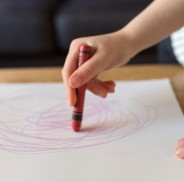by Danielle Carter, MS OTR/L
As an Occupational Therapist I am often asked by preschool teachers and parents about purchasing pencil grippers to assist their 4-5 year olds who are not yet using a mature crayon grasp. While there is certainly a time during the school aged years for compensatory approaches such as a pencil gripper, in preschool age children the goal really should be on developing underlying building block skills and refining grasp patterns.
The following activities can help children build foundational skills which allow mature grasp patterns to emerge without the use of compensatory strategies. Kidspeak Occupational Therapists are a great resource if you have continued concerns with your child’s grasp patterns and fine motor development.
Activities to promote weight bearing for palmer arch development, and shoulder girdle and core strength and stability:
- Wheelbarrow walking (encourage open palms and fingers facing forward).
- Playing/reading on tummy to encourage weight bearing through shoulders and palms. If it’s more comfortable, have your child put his/her chest on pillow.
- Sitting on yoga ball when playing board games.
- Crossing the midline by presenting toys to the opposite side and having your child reach across his/her body.
- Playing simple board games while on all 4’s (hands and knees) making sure fingers are pointed forward, hands are open versus fisted and elbows aren’t locked.
- Animal walks (crab walk, bear walk, snake) help with weight bearing, strength and stability.
Activities to develop intrinsic hand muscles:
- Watering plants with squirt bottle.
- Have your child color with markers on a coffee filter and then spray it with a squirt bottle. You can then use a clothes pin to turn the coffee filter into butterfly wings (clothes pin is the body), or wrap a pipe cleaner around the coffee filter and turn it into a flower.
- Empty condiment bottle to play pom-pom hockey. Squeeze the air from the bottle at the pom-pom to make it move and try to blow it off the table for a goal.
- Finding beads in play-doh, games like Perfection, and small pop beads all use a pincer grasp.
- Stringing beads onto a pipe cleaner or string.
- Lego activities.
- Tweezer and tong activities
- Mr. Potato head, ripping paper, or other two handed activities to assist with using a “helper hand” to hold the paper later.
- Squirt toys in the tub.
Activities to promote wrist extension (using a fisted or pronated grasp is more difficult if the child’s wrist is extended):
- “Paint” a fence or the side of your house with water and a paint brush. The vertical surface helps with wrist extension.
- Rolling snakes with play-doh or kinetic sand, again encourage rolling all the way through for wrist extension.
- Vertical surfaces allow gravity to assist with wrist extension. Use an easel, color with window markers on a patio door, bath tub crayons, or a dry erase board on the wall.
Body awareness/Motor Planning:
- Obstacle courses that include a change of head position, walking on uneven surfaces (couch cushions, balance pods/boards), etc.
- Crawling through tunnels.
- Playing outside on playground equipment.
- Doing “heavy work” and helping with carrying groceries, laundry basket, etc.
While the above activities are just a few of the many ways to develop the underlying skills necessary for pre-writing and coloring, here are a few additional things to keep in mind for when your child is using a crayon or pencil:
- The size and shape of the writing tool does matter. Wedge crayons, broken piece of chalk, or a golf sized pencil, are better choices for a preschooler than a full-sized pencil. These tools make using a fisted grasp more difficult and encourage a more functional position.
- For table top fine motor activities, it is best to seat your child at child size table or another space where his/her feet touch the ground. Ideally you want hips, knees and feet at 90 degrees of flexion.

